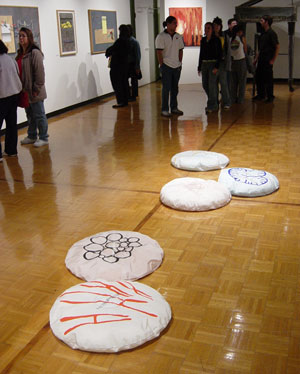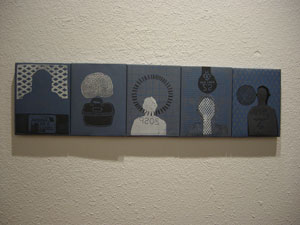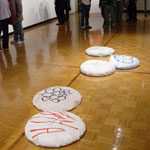Currently showing at the UTEP student gallery is a small show, Fused, which brings together international students, teachers and professional artists with very different sensibilities.
Two particularly innovative artists are in the show, one from Germany and the other from Iceland. Ursula Eckert, an artist from Germany whose one-of-a-kind prints present a personal iconography fused with more traditional symbols in pursuit of the big themes (like life and death). Pushing the boundaries of traditional printmaking, she produces her images not on a press, but rather with such things as styrofoam packaging and foam board. Her themes and symbols are both universal and highly personal: bowls stand for the concealed or hidden aways.
Three pieces of Eckert’s hang together. Entitled Between, Table and Boat, they explore the theme of transformation. In Between, a chrysalis shape containing a cross stands between a church outline and gray wide stripes; the church is, in fact, from a larger series Eckert made which was influenced by the Chartres Cathedral as well as her own religious upbringing. The imagery and the red and gray muted tones in Between (the same colors as in the other two prints) share a preoccupation with the mystery of what lies beyond death. Boat contains the same chrysalis form, and a boat with symbols of infinity and a cross form — an unmistakable reference to the mythology of the boat that leads into the underworld.
In addition to her prints, Eckert has filled the floor with a series of used car air bags, which she has transformed into something of a meditation. Each bag has been filled to form a cushion, and painted in different colors with chromosome patterns. With titles such as Enduring and Impregnable, the bags with their painted-on DNA suggest the transitory and the eternal, themes which relate back to her prints. One is aware that these airbags had been deployed–did the user survive? Like an abstracted representation of the human form, each bag has a different shape and color, ghostly reminders of the individuals whose bodies came into sharp contact with these objects in near-death (or all-death) experiences.
Svala Olafsdottir explores memory and her native culture in Iceland. Her two black and white photographs capture personal items collected from her homeland: bird nests wrapped with wool and a doll wrapped in wool, rocks and glass. Reluctant to discuss her work directly, she is clearly concerned with the haunted memories of a sort of collective conscience of childhood memory.
Eckert’s and Olafsdottir’s works made me wonder about contemporary art in Germany and Iceland, and I was able to talk to Ursula and Svala about their work and art in general.
“In order to understand art in Iceland, you must first understand the people and the weather.” explained Olafsdottir. “There are 6 months of darkness and only 3 months of full days of light. In addition, the tectonic plates of the earth join right through Iceland, so it gives one an interesting sense when the earth shifts.” This is a culture which has a long tradition of storytelling to ward off the long winter nights. The Icelandic sagas, Eddas, form a fundamental part of the national culture. Olafsdottir points out that Iceland is a bit of a melting pot, with artists looking both to the East and West coasts of America as well as to the rest of Europe for certain techniques and ideas; but at the same time, they are fiercely proud of their own culture and country. The techniques may be imported, but they are generally employed in the service of exploring a national culture. Her collaged sculptures come out of the tradition of Icelandic landscape painting, where artisits in the past have used rocks, dirt and found debris like wool and glass on their paintings. National pride has a place in much of contemporary Icelandic art; in a recent museum show there, most of the young artists were exhibiting works revealing pride in the national character and unique Icelandic identity, with an emphasis on the much older traditions of storytelling and Icelandic mythology.
For her part, Eckert points out that in Germany, although regions are extremely different from each other even in the matter of language, there is still a shared sense of culture through such things as the folk tales of the Brothers Grimm, whose fables, like that of Rumplestiltskin, often incorporate multiple versions of ancient, pre-Christian mythologies. These old myths and stories are once again coming into prominence after a long period of subversion after the fallout from World War II. A more recent (but no less influential) figure is Joseph Beuys, whom Eckert cites as being perhaps the biggest influence on contemporary German artists. Yes there were other artists who were influential, yes there was the Bauhaus, but after the Second World War, people, obviously traumatized, did not want to look at anything ugly “but Beuys showed us it was ok to talk about those things–it was all right to have nails and ugliness. It was all right to have something other than pretty art to go above your sofa.” Both Eckert and Olafsdottir credit Beuys, and the Fluxus movement generally, with a lasting influence on European artists.
Both these artists, like their countrymen, seem to be open to experimenting with forms, images and techniques from a wide variety of influences, from air bags to discarded dolls to disposable pop culture, all the while operating within a sense of national identity that only comes from centuries of mythology. American artists since the 60’s have likewise referenced their national culture, only they have limited themselves (generally) to more recent manifestations of pop culture (think Hollywood, the comic book, and the endless debris of disposable consumer goods. For better or for worse, at least to American eyes, both Eckert and Olafsdottir seem to be drawing from a somewhat deeper well for those stories that we tell each other through art.
Images courtesy the University of Texas at El Paso Gallery.
David Sokolec is a writer living in El Paso.





